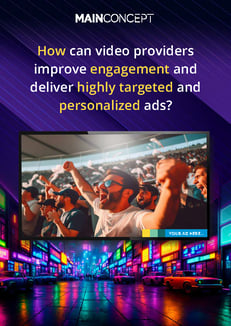
3 ways ad insertion impacts ad performance
Read the white paper to learn how to utilize codes to improve ad engagement and monetization.
 Ads are making a big comeback, with consumers increasingly turning to free or reduced cost ad-based streaming services for their entertainment. This is a great opportunity for broadcasters to maximize ad revenue by providing great engagement rates. We know engagement rates are better when viewers are shown ads that are relevant and align closely with their personal interests and needs. However, how ads are seen by viewers is also important. Interrupting the viewing experience with an ad-break can cause frustration, lead to disengagement, and even cause people to switch off altogether.
Ads are making a big comeback, with consumers increasingly turning to free or reduced cost ad-based streaming services for their entertainment. This is a great opportunity for broadcasters to maximize ad revenue by providing great engagement rates. We know engagement rates are better when viewers are shown ads that are relevant and align closely with their personal interests and needs. However, how ads are seen by viewers is also important. Interrupting the viewing experience with an ad-break can cause frustration, lead to disengagement, and even cause people to switch off altogether.
Here are 3 ways in which ad insertion can impact performance:
1. How you insert content in the workflow
Where the ad is inserted within the chain is an important consideration when planning your strategy. There are two main methods of ad insertion: client-side ad insertion (CSAI) and server-side ad insertion (SSAI). Each method has its own benefits, and the choice between them depends on factors like user experience goals, ad revenue strategies, and technical considerations.
With CSAI, ads are inserted into the video stream at the point of delivery. This avoids complex video processing and is already widely used in OTT advertising. However, this method has a few issues. Ad-blockers can prevent ads from being displayed and inserting ads in the stream can cause buffering delays. Ad insights can also be inaccurate as some ad impressions may not track correctly due to technical issues.
SSAI involves inserting ads into the video stream on the server side before delivering content to the viewer's device. SSAI is gaining in popularity as it improves ad measurement and provides a smoother viewing experience. It can also deliver ads to any device, improving ad reach.
2. Innovate your ad formats
Ad breaks have been the standard method of delivery since the start of TV. Broadcasters are now looking to other formats to drive viewer interest in ad content. A popular alternative is to overlay ads onto the main body of video content, removing the need to pause content and disrupt the viewing experience. Packaged as a banner or small pop-up, non-invasive overlay ads can deliver ad content subtly without hindering the viewer experience through frequent interruptions. Overlay ads can be utilized cleverly to deliver targeted ads to the viewer, with organic pairings between ad and video content promoting great engagement. It is important to gauge how many overlay ads are shown; too many and the viewer could get ad fatigue.

3. Utilize codecs to improve ad delivery
You know that codecs are at the core of video delivery, but are you utilizing them to their fullest? By choosing the right codec for the specific ad insertion method employed, video providers can ensure that ads are more efficient, optimized, and intelligent. Ads can be placed as an overlay using a banner, or shaped around the content, or even as an immersive insert, where a product is placed within the content. Ads can be inserted in tiled, multi-layered and sliced format. Understanding which codec to use and when is critical in delivering truly flexible and high-quality advertising. Server-side ad insertion supported at video codec-level can even enable hyper-specific, personalized ads to be delivered to the viewer, transforming how ads are seen and engaged with and ultimately improving revenue.

To learn how to utilize codes to improve ad engagement and monetization, read our latest white paper now.



